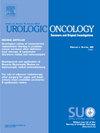对患有晚期激素敏感性前列腺癌的西班牙裔和非西班牙裔男性进行组织、液体和种系检测的回顾性分析。
IF 2.4
3区 医学
Q3 ONCOLOGY
Urologic Oncology-seminars and Original Investigations
Pub Date : 2025-05-01
DOI:10.1016/j.urolonc.2025.02.011
引用次数: 0
摘要
简介:前列腺癌(PCa)是美国男性癌症死亡的主要原因,存在明显的种族和民族差异。西班牙裔美国人(HAs)在前列腺癌基因组研究中代表性不足,尽管他们占癌症诊断的很大一部分。通过比较HA和非西班牙裔(NHs)之间常见PCa突变的频率,我们的目标是继续了解这一代表性不足的人群中差异的驱动因素。方法:我们回顾性分析了亚利桑那大学癌症中心(2015-2023)111例转移性前列腺癌患者的313例组织、液体和种系基因组样本结果。患者按种族分为HAs和NHs。我们评估了去识别的人口学、病理、临床和基因组数据。分别使用t检验或Kruskal-Wallis秩和检验和卡方检验或Fisher精确检验评估确定统计显著性的连续变量和分类变量(P )结果:纳入的111例患者中HAs占41%。HAs患者在诊断时PSA水平中位数较高(148.5 ng/ml vs. 52.6 ng/ml, P = 0.024),病理分期更晚期,包括T4 (36% vs. 15%)和M1c(37.8% vs. 0.024)。13.6%),到一线治疗的时间更短(1个月vs 2个月,P ≤ 0.01),从一线到二线治疗的中位生存时间更高(23 vs 13个月,P 10)突变在HAs中更常见(36% vs. 6%, P = 0.0009; vs 20%。3%, P = 0.003)。结论:我们的研究显示,与NHs相比,HAs PCa的临床表现更先进。此外,ha和NHWs之间PCa的显著基因组差异,特别是TMPRSS2-ERG融合和TMB-High突变,突出了早期检测和个性化治疗选择的必要性。解决治疗差异和扩大HAs的基因组研究对于在这一代表性不足的人群中制定有效的干预措施至关重要。本文章由计算机程序翻译,如有差异,请以英文原文为准。
A retrospective analysis of tissue, liquid, and germline testing in Hispanic and non-Hispanic men with advanced hormone-sensitive prostate cancer
Introduction
Prostate cancer (PCa) is a major cause of cancer mortality among American men, with significant racial and ethnic disparities. Hispanic Americans (HAs) are underrepresented in PCa genomic studies despite comprising a large portion of cancer diagnoses. By comparing the frequency of common PCa mutations between HA and non-Hispanics (NHs), we aim to continue understanding the drivers of disparities in this underrepresented population.
Methods
We retrospectively analyzed 111 metastatic prostate adenocarcinoma patients with 313 tissue, liquid, and germline genomic sample results from patient blood at the University of Arizona Cancer Center (2015-2023). Patients were categorized by ethnicity into HAs and NHs. We assessed de-identified demographic, pathological, clinical, and genomic data. Continuous and categorical variables determined statistical significance were evaluated using t-tests or Kruskal-Wallis Rank sum tests and Chi-square or Fisher's exact tests, respectively (P < 0.05). Time-to-event data was analyzed using Kaplan-Meier Methods.
Results
Of the 111 patients included HAs represented 41%. HAs had higher median PSA levels at the time of diagnosis (148.5 ng/ml vs. 52.6 ng/ml, P = 0.024), more advanced pathological disease stages, including T4 (36% vs. 15%), and M1c (37.8% vs. 13.6%), less time to first-line treatment (1 vs 2 months, P ≤ 0.01), and higher median survival time from first-line to second-line treatment (23 vs 13 months, P < 0.01). TMPRSS2-ERG fusion and TMB-High (>10) mutations were more common in HAs (36% vs. 6%, P = 0.0009; 20% vs. 3%, P = 0.003).
Conclusion
Our study shows a more advanced clinical presentation of HAs PCa compared to NHs. Furthermore, significant genomic differences in PCa between HAs and NHWs, particularly in TMPRSS2-ERG fusion and TMB-High mutations, highlight the need for early detection and personalized treatment options. Addressing treatment disparities and expanding genomic research in HAs are crucial for developing effective interventions in this underrepresented population.
求助全文
通过发布文献求助,成功后即可免费获取论文全文。
去求助
来源期刊
CiteScore
4.80
自引率
3.70%
发文量
297
审稿时长
7.6 weeks
期刊介绍:
Urologic Oncology: Seminars and Original Investigations is the official journal of the Society of Urologic Oncology. The journal publishes practical, timely, and relevant clinical and basic science research articles which address any aspect of urologic oncology. Each issue comprises original research, news and topics, survey articles providing short commentaries on other important articles in the urologic oncology literature, and reviews including an in-depth Seminar examining a specific clinical dilemma. The journal periodically publishes supplement issues devoted to areas of current interest to the urologic oncology community. Articles published are of interest to researchers and the clinicians involved in the practice of urologic oncology including urologists, oncologists, and radiologists.

 求助内容:
求助内容: 应助结果提醒方式:
应助结果提醒方式:


